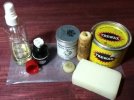I have seen some knives come with a Teflon (PTFE) surface to aid in decreasing the resistance when cutting certain materials. But others have said on here such finishes wear off when cutting very abrasive/fibrous materials and then that feature-point is gone.
I have been coating my knives in Renaissance wax for years to help protect them from moisture, make them look and feel nicer and possibly aid cutting. Then years later I found info on Dry PTFE lubricants and that they are very very good to use on cutting blades and saws to help things not stick to them and increase their cutting life etc.
So for the past few months I have been combining this by coating my knives in the wax and while it is still wet I give them a good spray of WD40 Specialist Dry Lubricant (PTFE) which evaporates quick to leave the microscopic particles in place to act as a lubricant. Then I finger paint around with it to help mix it into the wax, leave to dry, buff up and then apply a really thin quick extra wax layer and give it a quick immediate buff and spray a quick spray of PTFE on the top of that and leave, then gently buff. My goal was to provide a drop in resistance through cutting, by adding more PTFE throughout the wax to hopefully withstand more cutting before needing to repeat the process.
I have noticed the effect lasting a nice amount of time and I can angle my knife at a light source and see rainbow colours.
Has anyone else tried anything like this? Any thoughts or theories about the effectiveness of this? It appears to be useful, to me, but I am not exactly a scientist either.
I have been coating my knives in Renaissance wax for years to help protect them from moisture, make them look and feel nicer and possibly aid cutting. Then years later I found info on Dry PTFE lubricants and that they are very very good to use on cutting blades and saws to help things not stick to them and increase their cutting life etc.
So for the past few months I have been combining this by coating my knives in the wax and while it is still wet I give them a good spray of WD40 Specialist Dry Lubricant (PTFE) which evaporates quick to leave the microscopic particles in place to act as a lubricant. Then I finger paint around with it to help mix it into the wax, leave to dry, buff up and then apply a really thin quick extra wax layer and give it a quick immediate buff and spray a quick spray of PTFE on the top of that and leave, then gently buff. My goal was to provide a drop in resistance through cutting, by adding more PTFE throughout the wax to hopefully withstand more cutting before needing to repeat the process.
I have noticed the effect lasting a nice amount of time and I can angle my knife at a light source and see rainbow colours.
Has anyone else tried anything like this? Any thoughts or theories about the effectiveness of this? It appears to be useful, to me, but I am not exactly a scientist either.

